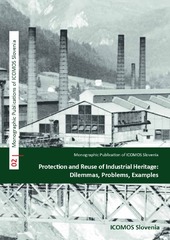Prikaz osnovnih podataka o dokumentu
Dilemmas and Problems in Active Reuse of Belgrade Industrial Architecture - The Case Study of the Sava River Area
| dc.contributor | Ifko, Sonja | |
| dc.contributor | Stokin, Marko | |
| dc.creator | Roter Blagojević, Mirjana | |
| dc.creator | Nikolić, Marko | |
| dc.date.accessioned | 2020-05-12T18:58:03Z | |
| dc.date.available | 2020-05-12T18:58:03Z | |
| dc.date.issued | 2017 | |
| dc.identifier.isbn | 978-961-288-173-3 | |
| dc.identifier.uri | https://raf.arh.bg.ac.rs/handle/123456789/690 | |
| dc.description.abstract | Exploration of possibilities of protection, rehabilitation and envision of sustainable strategies for development of industrial areas and buildings are important topics which have dominated in the sphere of theoretical and practical work in the field of protection of industrial heritage in the last decades. The focus is not only on their physical protection but also on the broader issues related to the contemporary reuse as places with cultural and tourism potentials. That is important for urban and economic development of the industrial areas, but that need to be in accordance with preservation of integrity and authenticity of the place. In the last decades, development of Belgrade has had a negative effect with regard to the industrial heritage built in the late 19th and early 20thcentury. The lack of understanding of preservation of elements which possess technological value as evidence of a certain level of development of technological culture as well as intangible heritage connected to the life and labour of workers is observed as the foremost problem. In order to stop this tendency and demonstrate a will to achieve further sustainable development, it is necessary to redefine the approach to the protection of Belgrade industrial zones, creating a new one for urban and spatial planning, taking into account all the values, tradition, authenticity and identity. With provided reconstructions and inadequate changes in the city industrial zones, particularly along the Sava River bank, the historical cityscape, with its characteristic morphology and typology, is gradually fading away. A more active cooperation between Serbia and The International Committee for the Conservation of the Industrial Heritage (TICCIH) as well as the ratification of The Nizhny Tagil Charter for The Industrial Heritage (2003) would definitely contribute to a better approach to the preservation of authenticity and integrity of industrial complexes within their repurpose and changes demanded by new, contemporary features, so that national and local institutions could take upon themselves the obligation to follow certain procedures and approaches in the protection of industrial heritage. | en |
| dc.language.iso | en | sr |
| dc.publisher | Ljubljana : ICOMOS Slovenija - Slovensko nacionalno združenje za spomenike in spomeniška območja = Slovenian National Committee of ICOMOS, International Council on Monuments and Sites | sr |
| dc.rights | openAccess | sr |
| dc.source | Protection and Reuse of Industrial Heritage: Dilemmas, Problems, Examples | sr |
| dc.subject | Industrial heritage | sr |
| dc.subject | Industrial areas | sr |
| dc.subject | Sustainable strategies | sr |
| dc.subject | Protection of industrial heritage | sr |
| dc.title | Dilemmas and Problems in Active Reuse of Belgrade Industrial Architecture - The Case Study of the Sava River Area | en |
| dc.type | bookPart | sr |
| dc.rights.license | ARR | sr |
| dcterms.abstract | Николић, Марко; Ротер Благојевић, Мирјана; | |
| dc.citation.spage | 25 | |
| dc.citation.epage | 35 | |
| dc.identifier.fulltext | https://raf.arh.bg.ac.rs/bitstream/id/1890/bitstream_1890.pdf | |
| dc.identifier.rcub | https://hdl.handle.net/21.15107/rcub_raf_690 | |
| dc.type.version | publishedVersion | sr |

